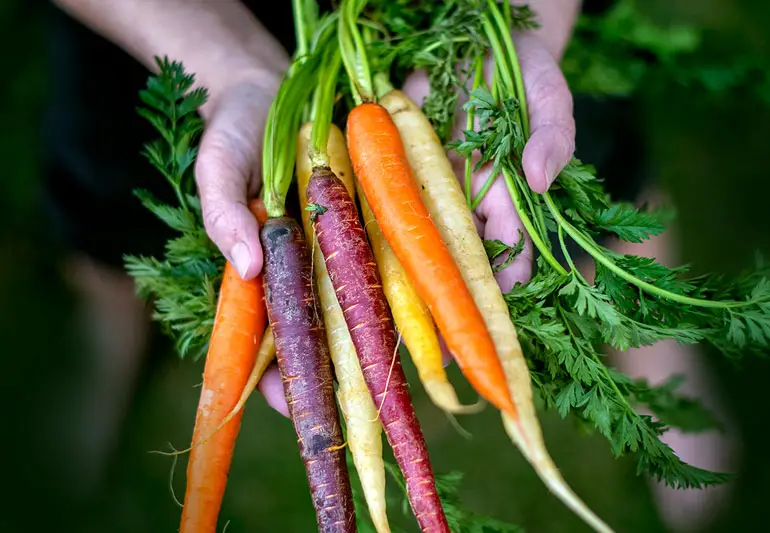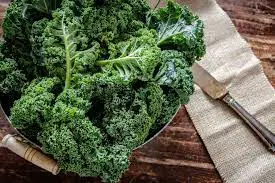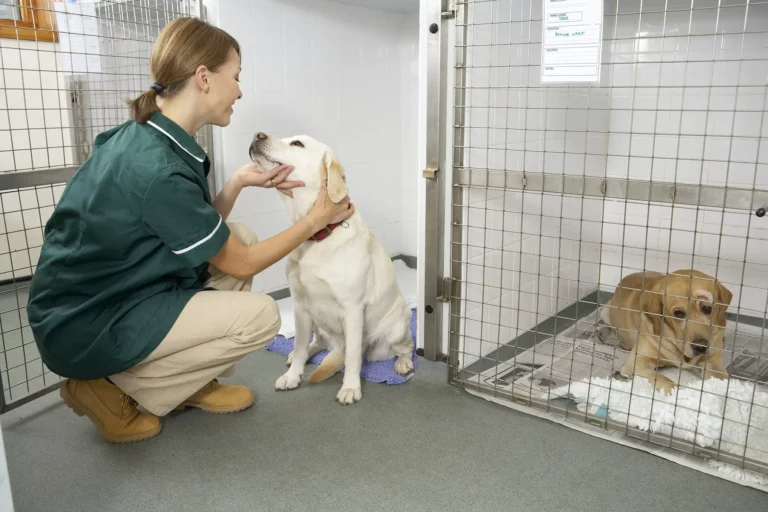Best Vegetables for Dogs – 5 Nutrition-Packed Vegetables Dogs Love to Eat
It’s important to make sure your pup is getting the best nutrition possible. Many vegetables can be great additions to their diet. Discover the top five veggies that are sure to give your furry friend a boost of vitamins and minerals.
In addition to the 5 best vegetable for dogs, this article covers:
- What vegetables are bad for dogs?
- How do you cook vegetables for dogs?
- Can dogs live healthy lives on a vegetarian diet?
The 5 best vegetables for dogs
Here’s a list of the five best vegetables for dogs they can eat every day.
1. Carrots

Carrots are rich in vitamins and minerals, like vitamin A, C, E and K. They are also packed with fibre. This helps keep your pup feeling full. Carrots also have lots of nutrients to support their health. Carrots can be served both raw or cooked to your pup in small pieces.
2. Kale

Kale is an excellent source of vitamins and minerals like iron, calcium, potassium, and magnesium. It’s also packed with antioxidants that can help reduce inflammation in your pup’s body. To make it easier to digest, kale should be boiled or steamed before serving it as a treat or part of your pup’s meal.
3. Broccoli
Broccoli has loads of nutritional benefits for dogs. It’s a great source of the antioxidant quercetin, kaempferol and isothiocyanates. It’s also an excellent source of fibre that helps your pup feel fuller longer. Boil or steam the florets before serving them to your pup as a snack or part of their meal.
No products found.
4. Spinach
Spinach is one of the best vegetables for dogs. It’s loaded with important vitamins and minerals. Spinach is a great source of vitamin A. It helps promote healthy vision, as well as calcium and iron for strong bones and muscles. Cook the spinach before giving it to your pup for easy digestion and maximum nutrient absorption.
5. Sweet Potatoes
Sweet potatoes are another great vegetable for dogs. Also, to being loaded with vitamins A, B6, and C, sweet potatoes also contain high levels of fibre. Not only does fibre help keep your pup’s digestive system running, but it can also help them feel fuller for longer between meals. Serve cooked sweet potatoes as a healthy snack or include them in your pups’ home-cooked meals!
What vegetables are bad for dogs?
While some vegetables can be an essential part of a healthy diet for humans, the same doesn’t hold true for your pup. In fact, certain vegetables are downright dangerous for dogs and should be avoided at all costs. To ensure the health and safety of your canine companion, it’s important to know which vegetables are toxic or unhealthy for them.
1. Onions and garlic
Both garlic and onions are considered toxic to dogs, so it’s best to avoid feeding your furry friend any kind of allium vegetable. This is due to the fact that both onions and garlic contain thiosulfate. Thiosulfate is a compound known for causing anaemia in animals when ingested in large quantities. Even if you’re only giving your pup tiny amounts of these veggies, it’s still better to stay on the safe side and omit them from your pup’s diet altogether.
2. Avocados
Avocados are toxic for dogs due to their high-fat content and a chemical compound known as Persin. Persin is not present in the avocado itself but can also be found in other parts of the tree, including its leaves, bark, and fruit. Ingestion of this chemical can result in vomiting and diarrhea in pups, so it’s best to avoid giving them any avocados whatsoever.
3. Tomato plants
Tomato plants and their fruits are both dangerous for your pup, as they contain a toxin called solanine. This compound is found in the stem of green tomatoes. It can cause nausea, vomiting, diarrhea, laboured breathing, tightness in the chest, and heart palpitations. Eating two to four leaves of the tomato plant can be enough to cause serious reactions.
4. Rhubarb leaves
Rhubarb leaves are especially dangerous for dogs if eaten due to their high concentration of oxalates. Eating these leaves can cause severe irritation, damaged tissues in the mouth, throat and stomach, extreme drooling, trembling, paralysis in the rear legs and/or difficulty breathing. Ingesting as little as 0.5 ounces per pound of a dog’s body weight can be toxic and even life-threatening.
5. Potatoes
Potatoes are found in many dog foods, but the leaves and stems of this vegetable can be poisonous to your pup. If a dog consumes the green parts or sprouts of a potato, they may experience vomiting and diarrhea due to an increased amount of solanine which is toxic to dogs. As with all other vegetables, it’s best to avoid feeding your pup potatoes altogether.
No products found.
How do you cook vegetables for dogs?
Cooking vegetables for your dog can be a wonderful way to provide them with the nutritious diet they deserve. But it’s important to know the proper steps and what ingredients to use to ensure their meals are safe and healthy. Here’s a step-by-step guide on how to cook vegetables for dogs.
1. Choose nutrient-rich vegetables.
This step is covered above but I’ll recap. It is important to choose nutrient-rich options such as sweet potatoes, carrots, squash, kale, spinach, cabbage and squash. Bagged or frozen vegetables are fine to use as long as they are low in sodium. Avoid onions, garlic and other alliums, which can be toxic to dogs.
2. Wash the ingredients well.
As with any meal, it is important to start with clean ingredients. Wash all vegetables with warm water and a scrub brush if necessary to remove dirt or other contaminants. Be sure to rinse them well and pat or air-dry for best results. You may also need to discard any wilted or mouldy pieces before cooking the meal.
3. Cut veggies into bite-sized pieces.
Once you’ve acquired and cleaned your vegetables, it’s time to prepare them for cooking. This means cutting them into bite-sized pieces that are easy for your dog to eat. Be sure to cut them evenly and thinly to ensure they cook properly and provide the most nutrition for your pet. You may need to adjust the size of the pieces depending on the size of your dog; smaller dogs need smaller chunks.
4. Boil, steam or stir-fry your veggie meal.
Once you’ve cut and prepped your vegetables, it’s time to decide how you will cook them. You can boil, steam or stir-fry your veggie meal, but boiling is generally the easiest and quickest way. Make sure to simmer the vegetables until they are softened; overcooked vegetables may not be digestible for your dog. If you choose to stir-fry your veggies, bring them to a light sizzle first before adding any oil or other flavorings as these can be unhealthy for your pet.
5. Sprinkle supplements if necessary and let cool before serving.
Depending on your dog’s individual dietary needs, you may wish to add a few supplements to the dish. Omega-3 fatty acid supplements, calcium, and vitamins can all be helpful additions when incorporated into a balanced meal. Don’t forget to let the vegetables cool before feeding them, as they will be hot coming off the stovetop and could burn your pup’s mouth. Once cooled, combine all ingredients with your dog’s regular food in a bowl and enjoy watching your pup enjoy their nutritious meal!
Can dogs live healthy lives on a vegetarian diet?
Are you wondering if dogs can maintain a healthy lifestyle when fed a vegetarian diet? Find out the facts about feeding your pup a vegetarian or vegan diet here.
Feeding your dog a plant-based diet can bring many benefits, such as fewer allergies and a decrease in skin and coat problems. Veggie-based diets are also often lower in fat than animal-based food, meaning that it can help to keep your pup at their optimal weight. Additionally, animals fed vegetarian diets tend to have better breath and fewer dental issues. This is due to a decrease in bacteria from the mouth cavity.
It is important to ensure that your dog’s vegetarian diet is nutritionally balanced and complete. This is because dogs are indeed true carnivores and have a higher protein requirement than humans do. As such, vegetable proteins should be combined to form a complete source of all essential amino acids for the canine body. Additionally, vitamins and minerals should be added to provide your pup with the necessary nutrition for them to thrive on their vegan diet.
Note that some commercial vegetarian formulas may contain fillers and unhealthy ingredients. So, it is important to read the nutrition label before purchasing any products for your pup.
Final Thoughts on the Best Vegetable for Dogs
Not all vegetables are equal as food for your dog. You can feed your pup veggies like kale, broccoli and carrots every day. These are considered the best vegetables for dogs. Other veggies suck as onion, garlic and avocado should be avoided.
I hope you found this information useful.







![Why is My Dog Panting at Night? [4 Reasons]](https://www.warmlypet.com/wp-content/uploads/2022/12/why-is-my-dog-panting-at-night-768x513.webp)